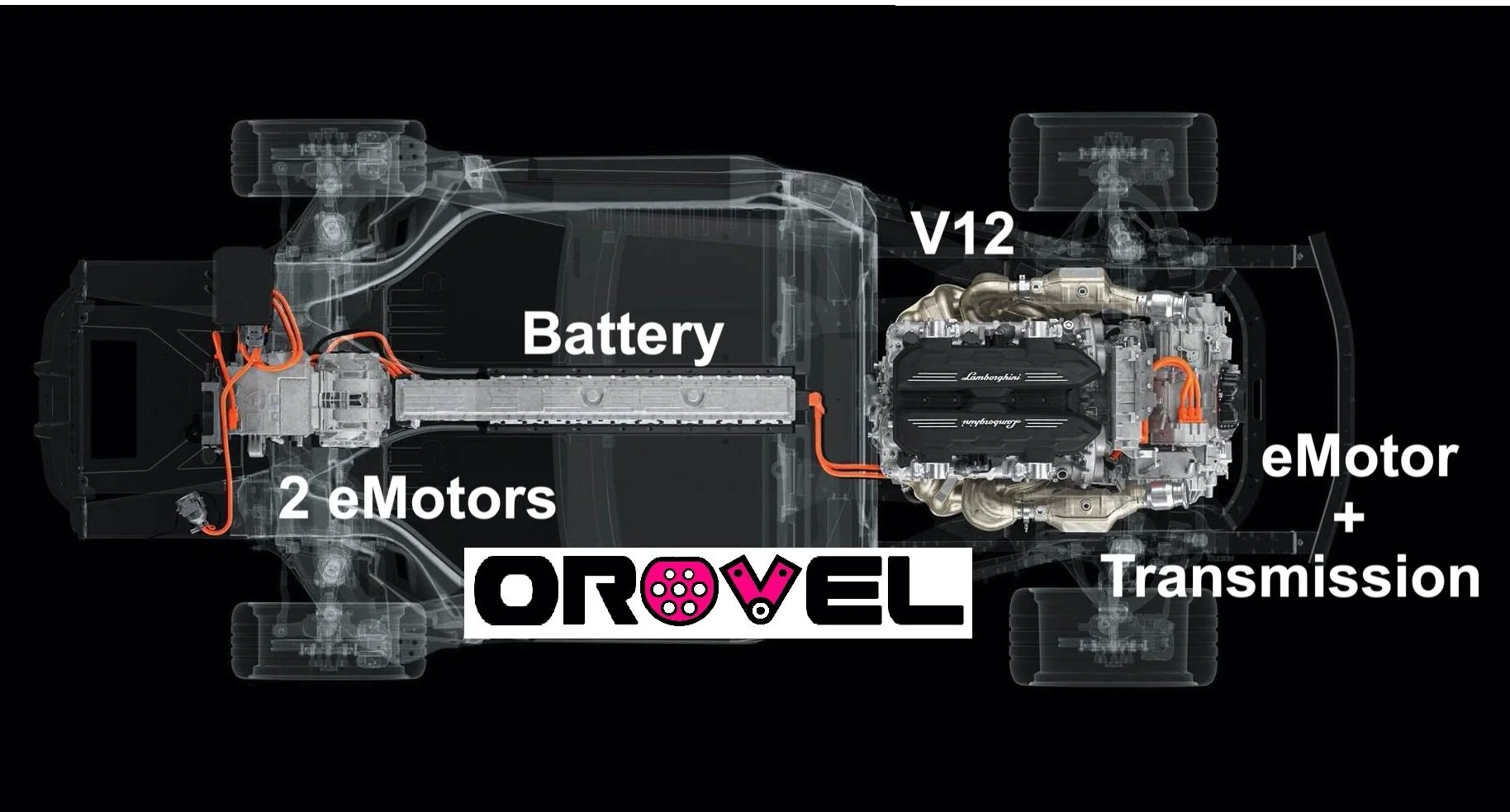Lamborghini V12 Hybrid Platform (LB744)
Lamborghini has developed a replacement platform for its flagship vehicle. As Electrification is ramping up, Lamborghini has chosen a Hybrid Platform which, contrary to the Sian, is a Plug-in-Hybrid.
Lamborghini uses the codename LB744 for its 1st HPEV (High Performance Electrified Vehicle) Hybrid Super Sport Car.
The platform delivers more than 1,000 CV in total by combining a new V12 Engine (Naturally-aspirated 6.5L) and 3 Electric Motors as well as a Lithium Battery.
1 eMotor is coupled with the V12 Engine
2 independent front eMotors
The car is able to run in Electric mode only. In this case, the car is front-wheel drive relying on the 2 front eMotors. The Rear-axle Electric Motor gets a very different job and is activated only for certain periods of time. It has 3 main functions:
It starts the V12 Engine; in this case it works like an Electric starter
It can recover a part of the Energy of the V12-Engine that would normally be lost during the braking phase. In this case, the eMotor acts like a generator that convert this Energy which is directed towards the Lithium Battery to be temporarily stored for later use. It works like a MGU-K (motor generator unit, kinetic) similarly to what is done in Formula 1
It can provide with additional power during maximum acceleration. In this case, it has the equivalent function of a super-electric boost (similarly to a TurboCharger)
Lamborghini Press Release and their YouTube video boast that the engine has been turned by 180-degrees and coupled with a relocated gearbox. Behind this complicated wording, this simply means that the V12 Engine is placed as it is normally in most of car (lol). Why is that? In most previous Lamborghini V12 cars, the Engine is actually placed “reverse” to most of the car. This is because such cars are 4WD and the gearbox is central in the vehicle to split power while minimising the length of the transmission shafts all connected to V12 Engine. In the new Hybrid platform, this constrain does not exist anymore as the 2 front Electric Motors can power the front wheels independently from the V12. In this case the Engine has been reversed (so is back to a normal orientation with flywheel at the back) and the transmission has been sent at the back for NVH reasons. Nevertheless, this flip-around must have asked Lamborghini quite some effort to redesign the V12 architecture.
The good news with the absence of transmission towards the front-wheels is that now you can free space in front of the engine, in-between the seats, and this is why the Lithium Battery is placed there instead of the usual transmission tunnel.
The 2 front Electric Motors are oil-cooled Axial Flux similarly to what is done by YASA (now belonging to Mercedes). Please note that I use here the name of YASA as an example of similar eMotor but Lamborghini might be using another supplier. Lamborghini mentions a weight-to-power ratio of 18.5 kg for the 110kW unit (the press release says “an exceptional weight-to-power ratio: 18.5 kilograms from each of the 110 kW units” which is not very clear to me). This would mean a power-to-weight ratio of the eMotor of 6kW/kg. As a comparison, the Volkswagen ID.R is 13 kW/kg, the Koenigsegg Quark eMotor is around 9 kW/kg and the Maserati GranTurismo Folgore 9.2 kW/kg.
Very little is know about the Lithium Battery. Its capacity is 3.8 kWh which may sound small but is actually normal for this kind of High Performance Hybrid HyperCar (as a comparison the McLaren Speedtail has a 1.6kWh Battery while the Koenigsegg Regera has 4.5 kWh). The Battery has a packaging that can fit in the place of what was previouslly the transmission tunnel. Lamborghini revealed that they are using Pouch Cells which is the main trend for high Performance HyperCar at the moment. Lamborghini did not disclose the voltage but it is very likely to be 800V because you are targeting a very high C-rate for maximum boosting during acceleration. The Power density of the Battery is 4500 W/kg. From the pictures available in the press release, it seems that the Battery Pack is made from 6 modules
As for the cooling, nothing has been mentioned but for me, it looks very similar to what RIMAC has done in the past…
Any additional information or comment welcome.

